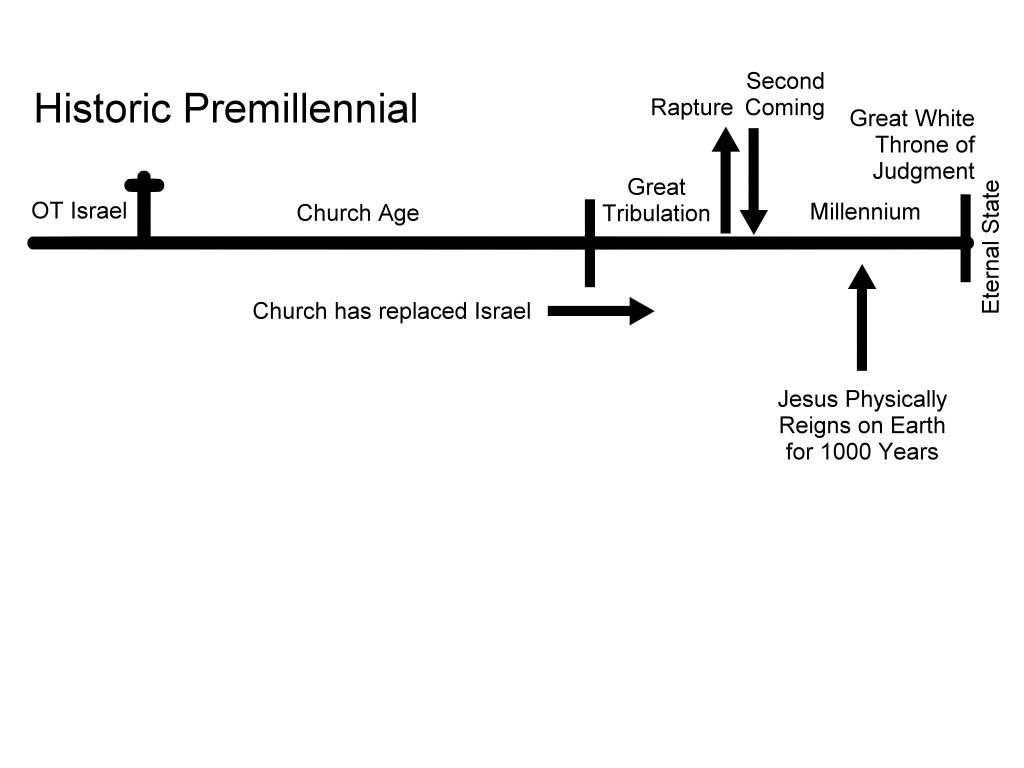Introduction:
There are certain chapters in the Bible that godly Christian people differ upon in their interpretation. Revelation 20 stands among one of the most discussed, and at times, hotly debated chapters among the 1189 chapters of God's Word. Today we want to note some key positions on the so-called "millennium" that one finds when studying this amazing chapter of the Book of Revelation. The term "millennium" itself means "thousand years", referencing the six occassions it is found in Revelation 20. Whether these references speak of a literal period of future time here on earth or a present, spiritual reign of Christ, constitutes the eye of the discussion.
Points upon which all Bible believing Christians agree in interpreting Revelation 20
Before getting to the differing interpretations, let us first consider what all Christians agree upon with regards to Christ's second coming generally and Revelation 20 in particular.
1. Christ's literally, bodily return.
Clearly all are in agreement that Christ will have a literal, bodily, visible return. According to Bible Teacher John MacArthur, 1 out of every 25 New Testament passages speak on His return. In all the major positions held about what we read in Revelation 19-20, virtually all interpreters are united in affirming that Revelation 19:11-21 is speaking about Christ's literal, bodily return to earth. Whichever view one holds about the millennium (see later on in this post), all agree that the Jesus in Revelation 20 is truly God and truly man. He reigns over His Kingdom depicted in Revelation 20 in a physical, glorfied body which He has retained since His ascension.
2. Revelation 20:11-15 finds near universal agreement.
In my consideration of the major viewpoints on Revelation 20 from listening to lectures, sermons and readings of nearly all the major creeds and confessions of church history, it is observed that the latter half of Revelation 20 (vss 11-15) finds near universal agreement. There is some debate over who exactly the "small and the great" are (whether they be believers and unbelievers or unbelievers only). Nevertheless, throughout church history, the major areas of emphasis on this particular section of Revelation has been the resurrection of the dead and final judgment. We read the following in Revelation 20:11-15
"Then I saw a great white throne and Him who sat upon it, from whose presence earth and heaven fled away, and no place was found for them. 12 And I saw the dead, the great and the small, standing before the throne, and books were opened; and another book was opened, which is the book of life; and the dead were judged from the things which were written in the books, according to their deeds. 13 And the sea gave up the dead which were in it, and death and Hades gave up the dead which were in them; and they were judged, every one of them according to their deeds. 14 Then death and Hades were thrown into the lake of fire. This is the second death, the lake of fire. 15 And if anyone’s name was not found written in the book of life, he was thrown into the lake of fire."
In considering the above two points, there is general uniformity on Revelation 20:11-15 (especially 20:14-15) as to the final judgment that will occur as the closing event before the eternity of Revelation 21-22.
What this means then is that our area of focus is narrowed down to Revelation 20:1-10. We can view what he wrote as one vision, comprised of three sections. Why the three sections? Whether we are reading the underlying Greek text or any English translation, certain "time indicators" point to a sequence within the vision. I'll underline them below for the reader's reference.
Revelation 20:1-3 "Then I saw an angel coming down from heaven, holding the key of the abyss and a great chain in his hand. 2 And he laid hold of the dragon, the serpent of old, who is the devil and Satan, and bound him for a thousand years; 3 and he threw him into the abyss, and shut it and sealed it over him, so that he would not deceive the nations any longer, until the thousand years were completed; after these things he must be released for a short time."
Revelation 20:4-6 "Then I saw thrones, and they sat on them, and judgment was given to them. And I saw the souls of those who had been beheaded because of their testimony of Jesus and because of the word of God, and those who had not worshiped the beast or his image, and had not received the mark on their forehead and on their hand; and they came to life and reigned with Christ for a thousand years. 5 The rest of the dead did not come to life until the thousand years were completed. This is the first resurrection. 6 Blessed and holy is the one who has a part in the first resurrection; over these the second death has no power, but they will be priests of God and of Christ and will reign with Him for a thousand years."
Revelation 20:7-10 "When the thousand years are completed, Satan will be released from his prison, 8 and will come out to deceive the nations which are in the four corners of the earth, Gog and Magog, to gather them together for the war; the number of them is like the sand of the seashore. 9 And they came up on the broad plain of the earth and surrounded the camp of the saints and the beloved city, and fire came down from heaven and devoured them. 10 And the devil who deceived them was thrown into the lake of fire and brimstone, where the beast and the false prophet are also; and they will be tormented day and night forever and ever."
Why there are differences of interpretation on Revelation 20:1-10
As mentioned, the real areas of difference of interpretation on Revelation 20 arise from how the first ten verses are approached, understood, and applied. The science and principles of interpretation are known as "hermeneutics". What follows below are five differences of interpretation one can note when reading books, articles, commentaries, and listening to sermons on Revelation 20. How one answers the following questions will determine whichever position one holds to on the millennium (whether Pre-millennial, Amillennial, or Post-millennial).
1. Is Revelation 20:1-10 recapping current history from Christ's resurrection to 2nd coming or is it following from His 2nd coming in Revelation 19:11-21?
2. Is the reference to "First Resurrection" speaking of salvation or of a future resurrection of the righteous at Christ's return?
3. Is Revelation 20:1-10 detailing more than one resurrection or is there only one general resurrection of both righteous and the wicked at the end of history? Many will include discussion of 20:11-15 in answering this question.
4. Is the Kingdom of Jesus Christ only spiritual and present, spiritual and earthly with an already/not yet component or entirely earthly in the future?
5. Is the number "1,000" a literal reference to a future 1,000 year reign of Jesus or is it a symbolic round number referring to His current reign in Heaven over the earth or a little bit of both?
Listing out the four major interpretations of Revelation 20:1-10
Three major positions, with one having two variations (and thus a total of four views in all), exist in determining the answers to various interpretive issues and questions outlined above. Though many details could be cited, yet for simplicity's sake, we will list each viewpoint, their names, and their broadest definitions.
1. Premillennialism - Those who hold to this teach that, when Christ returns, He will set up a literal earthly kingdom for 1,000 years, followed by a brief loosing of Satan to deceive the nations, the Great white throne judgment and then the bringing in of the "New Heavens and New Earth". The reason for the name "premillenialism" is due to the prefix "pre" referring to "before" and "millennium" being "1,000 years". As stated earlier, two variations exist within the Pre-millennial interpretation which for now we will just list their names:
a. Classical or Historic Premillennialism
Sometimes called "Post-Tribulational Premillennialism", this variation is the oldest of all the major eschatological or prophetic views on the millennium. Some of the early church fathers espoused this viewpoint, however, it must be noted that the stress laid upon the future earthly phase of Christ's kingdom here on earth. In more recent versions of this position, the timing of the tribulation has become more of a talking point. It regards the rapture (catching away of believers by Christ) and His second coming to earth as one event. One author has depicted this view as follows:
b. Dispensational Premillennialism (sometimes called "pretribulational premillennialism).
This position is most common in North America and somewhat in the British Isles (though not as much as it once was). When we say "dispensation", we refer to how God executes His providential dealings in different eras of history. It holds that due to distinctions between Israel and the Church, the Church will not have to endure the tribulation period. Sub-variations of this view exist between those who are pretribulational and those who believe God's wrath doesn't begin until midway through the tribulation, with the rapture occuring then (known as mid-triublationalism). There are those who claim this view is most recent, however, others will argue it was but a reclaiming of what earlier Christians taught. The imminency of the rapture of the church (that is, not knowing when it is going to occur) marks this view. Below is a comparison between this view and what will be the other remaining two major view of the millennium (Amillennialism and Postmillennialism).
Note: the picture above is from christinyou.com.2. Amillennialism.
We have so far observed two variations in the "premillennial camp" - namely classical premillennialism and dispensational premillennialism. We now will turn to a view that approaches Revelation 20:1-10 in a different light. This position (amillennialism) teaches that Christ began His reign at His ascension into Heaven and is ruling and reigning over a spiritual kingdom right now. Being that it denies a literal 1,000 year reign of Christ, the term "A-millenialism" is used (a=no and millennium = 1,000 years). History (according to this view) will continue in its downward spiral and at the end Christ will return, judging the world and Satan, and bring about the new heavens and new earth. We can summarize Amillennialism by the following diagram (picture derives from adventdc.com).
3. Post Millennialism
This position teaches that Christianity will continue to increase until the whole world is taken over by the gospel. Though not every individual will be saved, yet post-millennialists contend that every nation will eventually see many of their people saved. It generally teaches that the church will continue to evangelize until so many people are converted that Christ will then return at the end of the future golden age or "millennium" )post = "end" millennium= 1,000 years). Post-millennialists take passages such as Psalm 2 and missionary passages such as Matthew 28:18-20 to refer to the triumph of the gospel over unbelief. Below is a depiction of this view (also derived from the site adventdc.com).
As we close this post today, some may ask about the relevance of the debate. The big takeaway is that however you understand God's closing out of history governs how you live for Him today. Other related issues, such as how the church carries out the great commission; how we interpret Scripture; and how we prepare for His soon return are shaped by how one understands the questions I raised about Revelation 20 at the beginning of this post. I'll leave the reader with a list of resources that can aid greatly in personal study on this topic.
1. The Meaning of the Millennium: four Views. Edited by Robert G. Clouse. IVP Academic. 1977
2. Rose guide to Bible Prophecy by Timothy Jones. Rose Publishing, 2011.




















